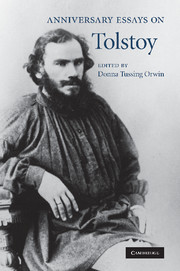Book contents
- Frontmatter
- Contents
- Acknowledgments
- List of contributors
- Introduction
- 1 Tolstoy and music
- 2 Sublime vision and self-derision: the aesthetics of death in Tolstoy
- 3 Tolstoy's peaceable kingdom
- 4 Leo Tolstoy: pacifist, patriot, and molodets
- 5 Leo Tolstoy's correspondence with Nikolai Strakhov: the dialogue on faith
- 6 The worm of doubt: Prince Andrei's death and Russian spiritual awakening of the 1860s
- 7 Tolstoy's spirituality
- 8 Tracking the English novel in Anna Karenina: who wrote the English novel that Anna reads?
- 9 Violence and the role of drama in the late Tolstoy: The Realm of Darkness
- 10 What men quote by: Tolstoy, wise sayings, and moral tales
- 11 The “proletarian lord”: Leo Tolstoy's image during the Russian revolutionary period
- Bibliography
- Index
2 - Sublime vision and self-derision: the aesthetics of death in Tolstoy
Published online by Cambridge University Press: 03 May 2010
- Frontmatter
- Contents
- Acknowledgments
- List of contributors
- Introduction
- 1 Tolstoy and music
- 2 Sublime vision and self-derision: the aesthetics of death in Tolstoy
- 3 Tolstoy's peaceable kingdom
- 4 Leo Tolstoy: pacifist, patriot, and molodets
- 5 Leo Tolstoy's correspondence with Nikolai Strakhov: the dialogue on faith
- 6 The worm of doubt: Prince Andrei's death and Russian spiritual awakening of the 1860s
- 7 Tolstoy's spirituality
- 8 Tracking the English novel in Anna Karenina: who wrote the English novel that Anna reads?
- 9 Violence and the role of drama in the late Tolstoy: The Realm of Darkness
- 10 What men quote by: Tolstoy, wise sayings, and moral tales
- 11 The “proletarian lord”: Leo Tolstoy's image during the Russian revolutionary period
- Bibliography
- Index
Summary
Death features prominently in Tolstoy's artistic and intellectual universe. Tolstoy's very first work, Childhood, a semi-fictional account of scenes inspired by his childhood, relates the 10-year-old protagonist's first confrontation with death when his mother unexpectedly succumbs to an illness. Tolstoy was about 2 years old when his mother died, and 9 when his father followed her. This initial painful realization of human mortality clearly exerted a profound impact, prompting him to recreate the image of his mother in Childhood and to return again and again to the theme of death in his subsequent works. Both War and Peace and Anna Karenina contain celebrated death scenes unparalleled in world literature, but shorter works have been just as powerful, in particular “Three Deaths,” The Death of Ivan Ilych, and The Kreutzer Sonata. Notable death scenes are also scattered in many, if not most, of his other pieces, including the Sevastopol sketches, The Cossacks, and Hadji Murat. The prominence of death in Tolstoy's oeuvre can hardly be overstated, and so it is no surprise that Philippe Ariès discusses Tolstoy's treatment of death at length in his seminal The Hour of Death, a survey of the history of dying in Western civilization.
Little Nikolenka, the protagonist and first-person narrator of Childhood, does not witness the final moments of his mother's life; he and his brother are led away from her deathbed, more out of concern for the dying mother than to spare the boys.
- Type
- Chapter
- Information
- Anniversary Essays on Tolstoy , pp. 33 - 51Publisher: Cambridge University PressPrint publication year: 2010
- 1
- Cited by



